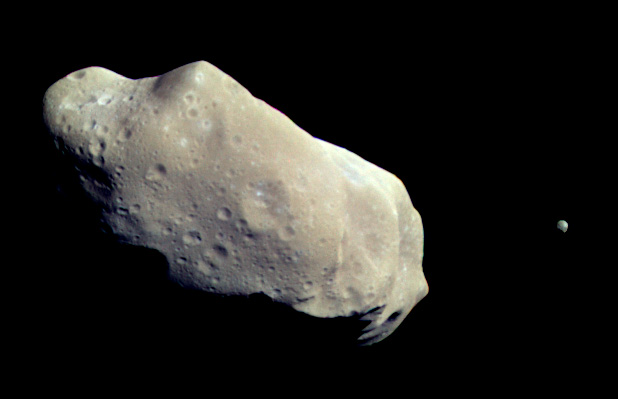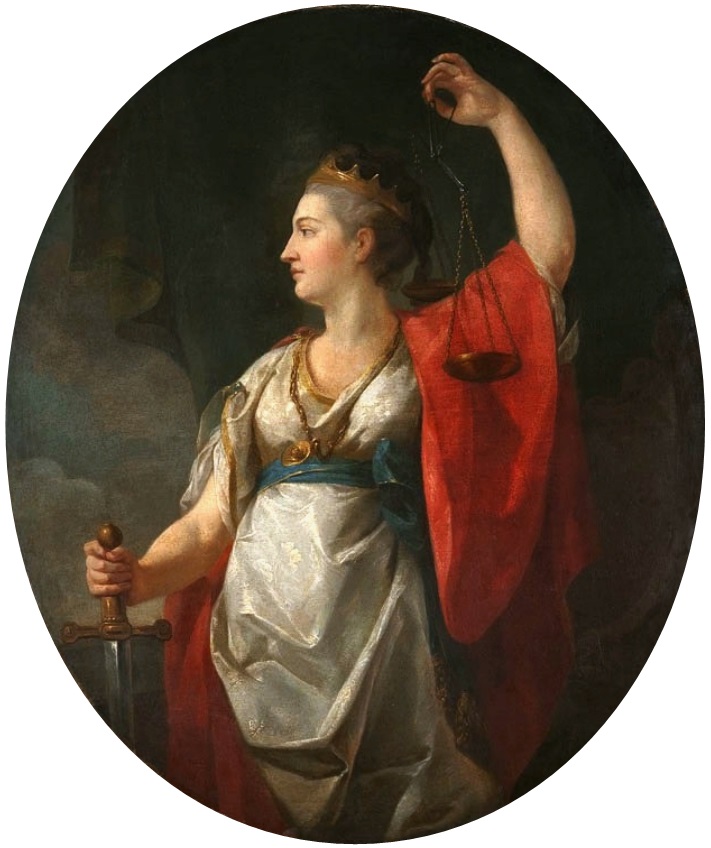|
379 Huenna
379 Huenna is a large asteroid orbiting in the asteroid belt. It is part of the Themis family, and thus a C-type asteroid and consequently composed mainly of carbonaceous material. It was discovered by Auguste Charlois on 8 January 1894 in Nice. It is the Latin name for the Swedish island of Ven, the site of two observatories. This island is where Tycho Brahe built his observatory. Satellite A satellite, 7 km across and designated S/2003 (379) 1, was discovered on 14 August 2003 by Jean-Luc Margot using the Keck II adaptive optics telescope at Mauna Kea. The moon orbits away in with an eccentricity of . The system is loosely bound as Huenna has a Hill sphere The Hill sphere is a common model for the calculation of a Sphere of influence (astrodynamics), gravitational sphere of influence. It is the most commonly used model to calculate the spatial extent of gravitational influence of an astronomical ... with a radius of about 20,000 km. References Exter ... [...More Info...] [...Related Items...] OR: [Wikipedia] [Google] [Baidu] |
Auguste Charlois
Auguste Honoré Charlois (; November 26, 1864 – March 26, 1910) was a French astronomer who discovered 99 asteroids while working at the Nice Observatory in southeastern France. Asteroid discovery His first discovery was the asteroid 267 Tirza in 1887. He photographed 433 Eros on the very night of its discovery by Gustav Witt, but was not able to act quickly enough before Witt announced his find. Although he started searching for asteroids in the era of visual detection, by 1891 Max Wolf had pioneered the use of astrophotography to drastically speed up the rate of detection of asteroids, and both Wolf and Charlois separately discovered far more asteroids than would have been feasible by visual detection. In 1899, Charlois received the Prix Jules Janssen, the highest award of the Société astronomique de France, the French astronomical society, and was also awarded the Valz Prize by the French Academy of Sciences in 1889 for his work on calculating asteroid orbits. Murder At ... [...More Info...] [...Related Items...] OR: [Wikipedia] [Google] [Baidu] |
Jean-Luc Margot
Jean-Luc Margot (born 1969) is a Belgian-born astronomer and a UCLA professor with expertise in planetary sciences and SETI. Career Margot has discovered and studied several binary asteroids with radar and optical telescopes. His discoveries include (87) Sylvia I Romulus, (22) Kalliope I Linus, S/2003 (379) 1, (702) Alauda I Pichi üñëm, and the binary nature of (69230) Hermes. In 2000, he obtained the first images of binary near-Earth asteroids and described formation of the binary by a spin-up process. Margot and his research group have studied the influence of sunlight on the orbits and spins of asteroids, the Yarkovsky and YORP effects. In 2007, Margot and collaborators determined that Mercury has a molten core from the analysis of small variations in the rotation rate of the planet. These observations also enabled a measurement of the size of the core based on a concept proposed by Stan Peale. In 2012, Margot and graduate student Julia Fang analyzed Kepler ... [...More Info...] [...Related Items...] OR: [Wikipedia] [Google] [Baidu] |
B-type Asteroids (Tholen)
B-type asteroids are a relatively uncommon type of carbonaceous asteroid, falling into the wider C-group; the 'B' indicates these objects are spectrally blue. In the asteroid population, B-class objects can be found in the outer asteroid belt, and also dominate the high-inclination Pallas family which includes the third-largest asteroid 2 Pallas. They are thought to be primitive, volatile-rich remnants from the early Solar System. There are 65 known B-type asteroids in the SMASS classification, and 9 in the Tholen classification as of March 2015. Characteristics Generally similar to the C-type objects, but differing in that the ultraviolet absorption below 0.5 μm is small or absent, and the spectrum is rather slightly bluish than reddish. The albedo also tends to be greater than in the generally very dark C type. Spectroscopy of B-class objects suggests major surface constituents of anhydrous silicates, hydrated clay minerals, organic polymers, magnetite, and sulfides. The clo ... [...More Info...] [...Related Items...] OR: [Wikipedia] [Google] [Baidu] |
Binary Asteroids
A binary asteroid is a system of two asteroids orbiting their common barycenter. The binary nature of 243 Ida was discovered when the Galileo spacecraft flew by the asteroid in 1993. Since then numerous binary asteroids and several triple asteroids have been detected. The mass ratio of the two components – called the "primary" and "secondary" of a binary system – is an important characteristic. Most binary asteroids have a large mass ratio, i.e. a relatively small satellite in orbit around the main component. Systems with one or more small moons – also called "companions" or simply "satellites" – include 87 Sylvia, 107 Camilla and 45 Eugenia (all triples), 121 Hermione, 130 Elektra (a quadruple), 22 Kalliope, 283 Emma, 379 Huenna, 243 Ida and 4337 Arecibo (in order of decreasing primary size). Some binary systems have a mass ratio near unity, i.e., two components of similar mass. They include 90 Antiope, , and 69 ... [...More Info...] [...Related Items...] OR: [Wikipedia] [Google] [Baidu] |
Named Minor Planets
Named may refer to something that has been given a name. Named may also refer to: * named (computing), a widely used DNS server * Naming (parliamentary procedure) * The Named (band), an American industrial metal group In literature: * ''The Named'', a fantasy novel by Marianne Curley * The Named, a fictional race of prehistoric big cats, depicted in ''The Books of the Named'' series by Clare Bell See also * Name (other) * Names (other) Names are words or terms used for identification. Names may also refer to: * ''Names'' (EP), by Johnny Foreigner * ''Names'' (journal), an academic journal of onomastics * The Names (band), a Belgian post-punk band * ''The Names'' (novel), b ... * Naming (other) {{disambiguation ... [...More Info...] [...Related Items...] OR: [Wikipedia] [Google] [Baidu] |
Discoveries By Auguste Charlois
Discoveries may refer to: Media Film and television * ''Discoveries'' (film), a 1939 British film * ''Discoveries'' (TV series), a Canadian youth science television series * "Discoveries", a Series D episode of the television series ''QI'' (2006) * "Discoveries" (''Hotel Portofino''), a 2022 TV episode Literature * ''Discoveries'' (Robertson Davies), a 2002 book by Robertson Davies * ''Abrams Discoveries'', a series of illustrated non-fiction books published by Harry N. Abrams * ''Discoveries'', a work by William Butler Yeats, written in 1907 * ''Discoveries'', a magazine published by Cedars-Sinai Medical Center Music * ''Discoveries'' (Cannonball Adderley album), 1955 * ''Discoveries'' (Josh Nelson album), 2011 * ''Discoveries'' (Northlane album), 2011 Other uses * Discoveries (horse), a racehorse See also * Age of Discoveries * Discovery (other) * Explorations (other) Exploration is the process of discovery. Exploration or explorations may ... [...More Info...] [...Related Items...] OR: [Wikipedia] [Google] [Baidu] |
Themis Asteroids
In Greek mythology and religion, Themis (; ) is the goddess and personification of justice, divine order, law, and custom. She is one of the twelve Titan children of Gaia and Uranus, and the second wife of Zeus. She is associated with oracles and prophecies, including the Oracle of Delphi. Name ''Themis'' means "divine law" rather than human ordinance, literally "that which is put in place", from the Greek verb ''títhēmi'' ( τίθημι), meaning "to put." To the ancient Greeks she was originally the organizer of the "communal affairs of humans, particularly assemblies." Moses Finley remarked of ''themis'', as the word was used by Homer in the 8th century BCE, to evoke the social order of the 10th- and 9th-century Greek Dark Ages: Finley adds, "There was ''themis''—custom, tradition, folk-ways, ''mores'', whatever we may call it, the enormous power of 'it is (or is not) done'." In the ''Hymn to Apollo'', Themis is referred to as " Ichnaea", meaning "Tracker". Des ... [...More Info...] [...Related Items...] OR: [Wikipedia] [Google] [Baidu] |
Very Large Telescope
The Very Large Telescope (VLT) is an astronomical facility operated since 1998 by the European Southern Observatory, located on Cerro Paranal in the Atacama Desert of northern Chile. It consists of four individual telescopes, each equipped with a primary mirror that measures in diameter. These optical telescopes, named ''Antu'', ''Kueyen'', ''Melipal'', and ''Yepun'' (all words for astronomical objects in the Mapuche language), are generally used separately but can be combined to achieve a very high angular resolution. The VLT array is also complemented by four movable Auxiliary Telescopes (ATs) with apertures. The VLT is capable of observing both visible and infrared wavelengths. Each individual telescope can detect objects that are roughly four billion times fainter than what can be seen with the naked eye. When all the telescopes are combined, the facility can achieve an angular resolution of approximately 0.002 arcsecond. In single telescope mode, the angular resol ... [...More Info...] [...Related Items...] OR: [Wikipedia] [Google] [Baidu] |
Brian D
Brian (sometimes spelled Bryan in English) is a male given name of Irish and Breton origin, as well as a surname of Occitan origin. It is common in the English-speaking world. It is possible that the name is derived from an Old Celtic word meaning "high" or "noble". For example, the element ''bre'' means "hill"; which could be transferred to mean "eminence" or "exalted one". The name is quite popular in Ireland, on account of Brian Boru, a 10th-century High King of Ireland. The name was also quite popular in East Anglia during the Middle Ages. This is because the name was introduced to England by Bretons following the Norman Conquest. Bretons also settled in Ireland along with the Normans in the 12th century, and 'their' name was mingled with the 'Irish' version. Also, in the north-west of England, the 'Irish' name was introduced by Scandinavian settlers from Ireland. Within the Gaelic-speaking areas of Scotland, the name was at first only used by professional families of Iri ... [...More Info...] [...Related Items...] OR: [Wikipedia] [Google] [Baidu] |
Jet Propulsion Laboratory
The Jet Propulsion Laboratory (JPL) is a Federally funded research and development centers, federally funded research and development center (FFRDC) in La Cañada Flintridge, California, Crescenta Valley, United States. Founded in 1936 by California Institute of Technology (Caltech) researchers, the laboratory is now owned and sponsored by NASA and administered and managed by Caltech. The primary function of the laboratory is the construction and operation of planetary robotic spacecraft, though it also conducts Earth-orbit and astronomy missions. It is also responsible for operating the NASA Deep Space Network (DSN). Among the major active projects at the laboratory, some are the Mars 2020 mission, which includes the ''Perseverance (rover), Perseverance'' rover; the Mars Science Laboratory mission, including the ''Curiosity (rover), Curiosity'' rover; the ''Mars Reconnaissance Orbiter''; the ''Juno (spacecraft), Juno'' spacecraft orbiting Jupiter; the ''Soil Moisture Active P ... [...More Info...] [...Related Items...] OR: [Wikipedia] [Google] [Baidu] |
Hill Sphere
The Hill sphere is a common model for the calculation of a Sphere of influence (astrodynamics), gravitational sphere of influence. It is the most commonly used model to calculate the spatial extent of gravitational influence of an astronomical body (''m'') in which it dominates over the gravitational influence of other bodies, particularly a Primary (astronomy), primary (''M''). It is sometimes confused with other models of gravitational influence, such as the Laplace sphere or being named the Roche sphere, the latter causing confusion with the Roche limit. It was defined by the United States, American astronomer George William Hill, based on the work of the France, French astronomer Édouard Roche. To be retained by a more gravitationally attracting astrophysical object—a planet by a more massive star, a natural satellite, moon by a more massive planet—the less massive body must have an orbit that lies within the gravitational potential represented by the more massive body ... [...More Info...] [...Related Items...] OR: [Wikipedia] [Google] [Baidu] |





